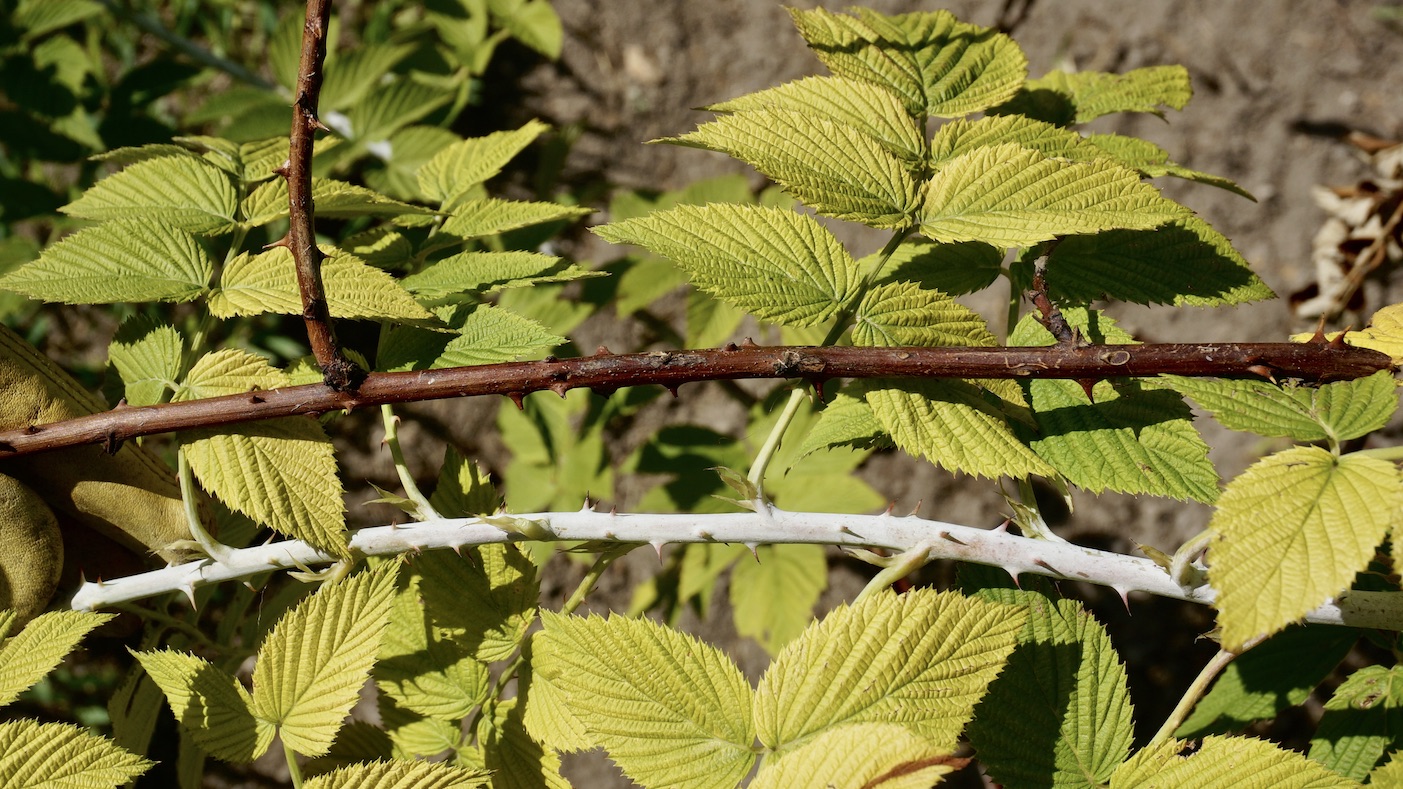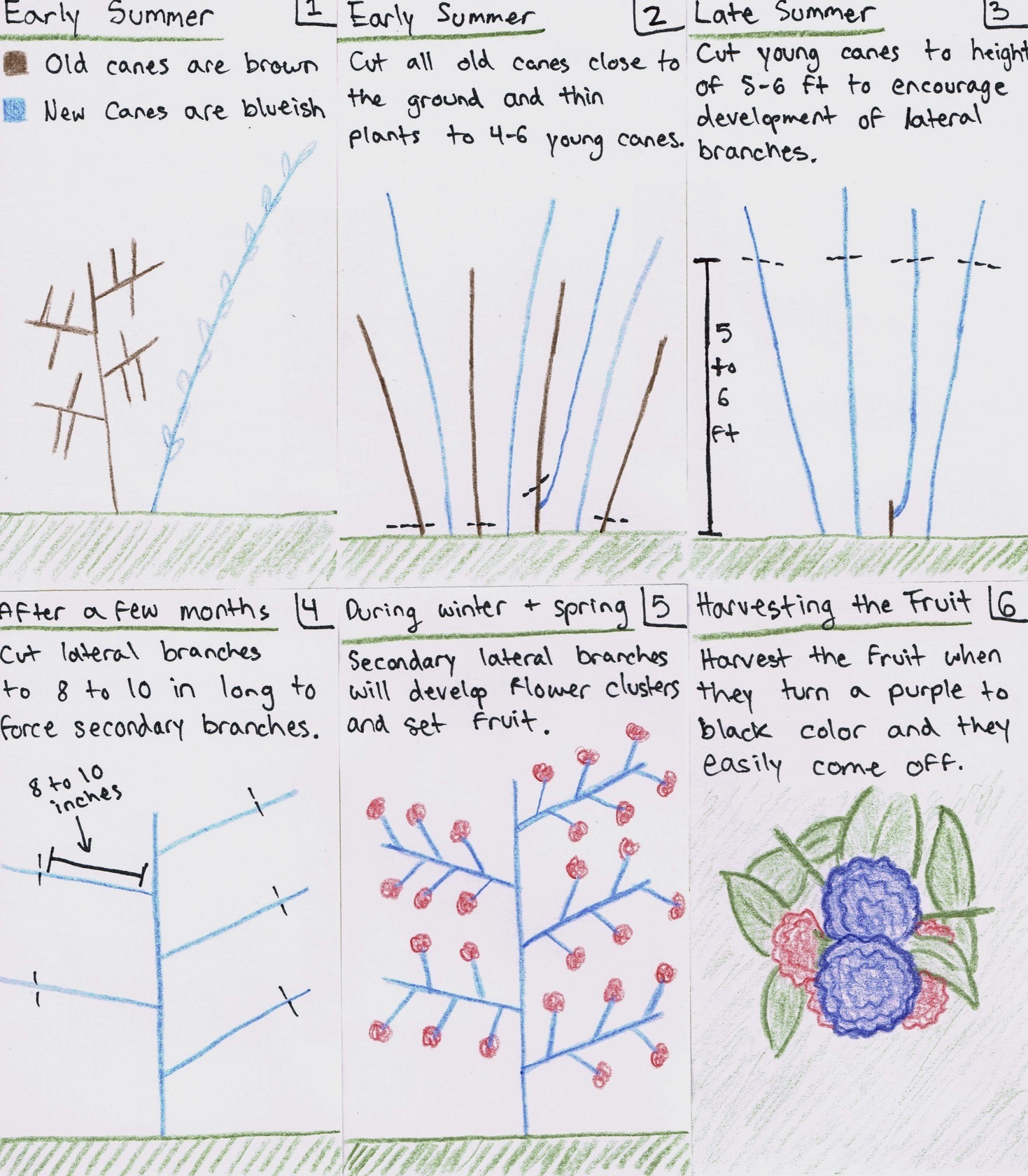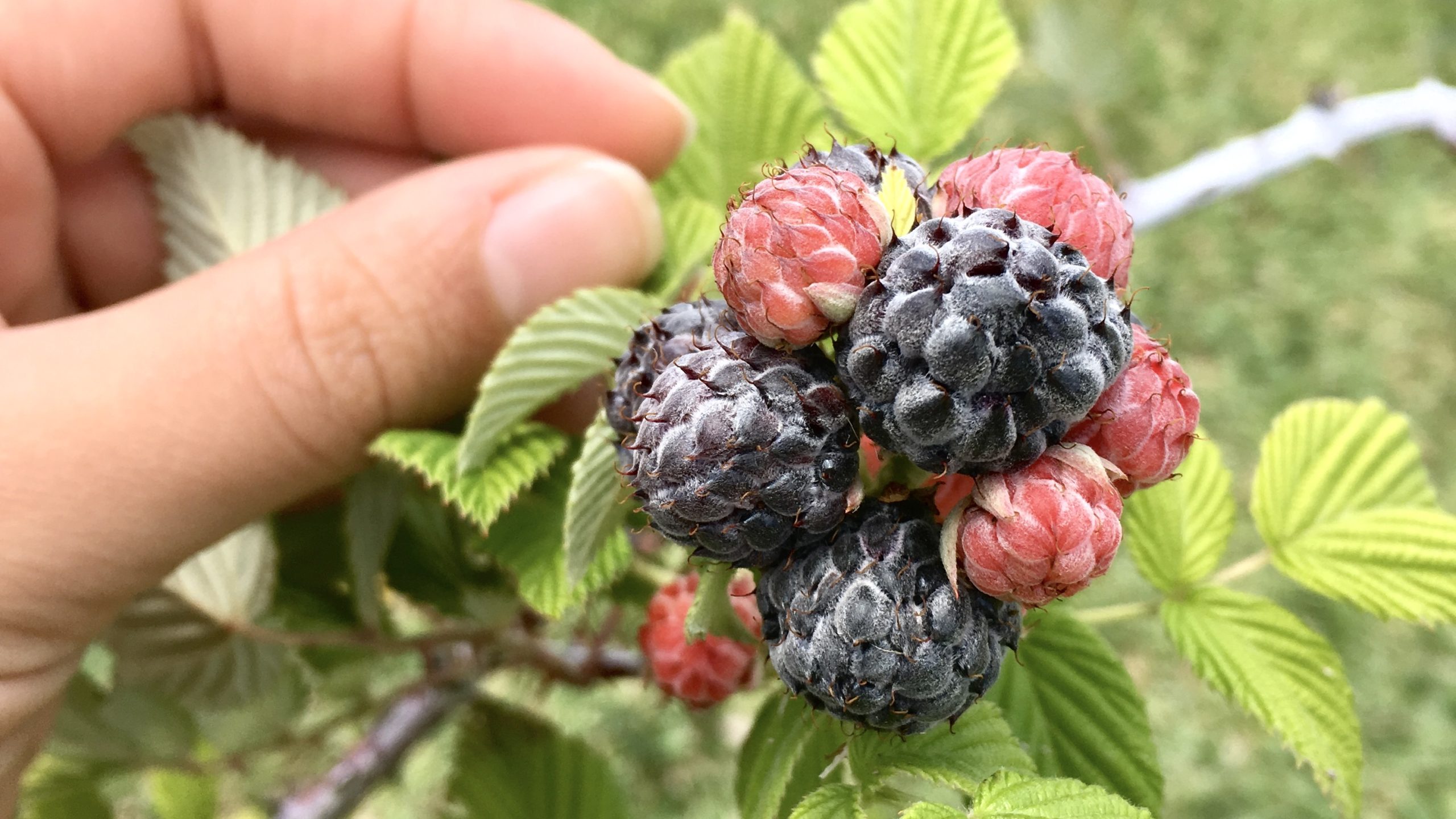All Posts > Blog

Introduction
Raspberries are typically grown in temperate climates. Many of the common raspberry varieties require a significant amount of chill hours in order to flower and set fruit. Mysore raspberries, on the other hand, can flower and fruit well in tropical climates. Their scientific name is Rubus neveus and they are native to India. I am not completely sure if Mysore raspberries require chill hours. Here in south Florida we get only a minimal amount of chill hours. If I had to guess, I would say we get at most 10-20 chill hours per year. The Mysore raspberry flowers and fruits well here with little to no chill hours.
Why Should You Prune Raspberries?
Pruning raspberries is very beneficial. When you prune raspberries you clear out older canes, increase air flow, and encourage lateral branching. Clearing out the older canes is really helpful in making harvesting easier. Some raspberries are thornless, however, the Mysore raspberry is covered in thorns. Even the underside of the leaves have tiny thorns on them! Pruning old canes out removes these thorny canes and increases air flow, which prevents disease. Encouraging lateral branching leads to bigger harvests too since the plants sets fruit on lateral branches.
When I first set out to research how to prune my Mysore raspberry I was a bit confused. The majority of the information online that I found was for temperate gardeners and I struggled to learn how to do it. Thankfully, I found a PDF produced by the University of Puerto Rico that went in depth on how to grow Mysore raspberries. You can click here to download the PDF or you can search for the title of the PDF, which is "The Mysore Raspberry, A New Fruit for Home Gardens in the Central-Western Mountainous Region of Puerto Rico."

Here you can see a step by step diagram on pruning your Mysore raspberry.
How to Prune Mysore Raspberries
Above you can see a diagram I made with a step by step guide on pruning the Mysore raspberry. I also made a video where I explain the process. The pruning process I explain here will be similar when pruning other black raspberry varieties. However, the timing of the pruning will be different if you are in a temperate climate.
Step 1: Removing Dead Canes
One raspberry plant will have multiple canes. Each cane will grow for two years and then it will die. From what I have seen, the Mysore raspberry only flowers and fruits on canes that are two years old. Canes that are one year old are called primocanes and canes that are two years old are called floricanes. You can tell the difference between primocanes and floricanes by their color. Primocanes on the Mysore raspberry have a blue/grey color while floricanes are dry and brown. Below you can see the two canes. The top one is a floricane and the bottom one is a primocane.
In early summer you need to cut all the floricanes close to the ground while leaving the primocanes. Sometimes a primocane will grow directly on a floricane a few inches up the cane. In this case, cut the floricane above where the primocane is attached. At this point you should also thin out the canes. Cut back the thinner smaller canes and leave 4-6 thick and healthy primocanes.

On the top is a floricane and on the bottom is a primocane.
Step 2: Tipping the Canes
In late summer you need to cut the primocanes to a height of 5 to 6 feet. You can cut them shorter or taller if you'd like. Cutting the canes will encourage lateral branches to form at every axil.
Step 3: Tipping the Lateral Branches
After a few months pass the canes will have grown lateral branches. In order to encourage secondary lateral branches to grow you need to cut the lateral branches to a length of 8 to 10 inches. Again, you can choose to cut the branches a little longer or shorter if you'd like. The main goal is to cut the tip of the lateral branch to encourage secondary branches.

Ripe and unripe Mysore raspberries.
Step 4: Wait for the Mysore Raspberries!
After step 3 you will see that the lateral branches begin to grow branches as well. These are secondary lateral branches and each of these will flower and set fruit. In Florida, the Mysore raspberry fruits in the winter and spring. Wait until the fruits are purple/black in color and easily come off when you pull them. After the plants are done fruiting return to step 1 and repeat the process.
I hope this post was helpful. If you have any questions or knowledge on the Mysore raspberry then please leave a comment down below. To learn about other plants that do well in warm climates click here. Thank you for reading!
Is the flower self pollinating or do I need to pollinate them manually? We dont have pollinators in our area.
I am not sure. I do know that with only one plant you will get fruit set. However, I am not sure if the plants require pollination. I would assume so. Some plants are pollinated by wind but I don't think the Mysore raspberry is pollinated just from wind.
Thank you so much for this!! I am a temperate organic produce market gardener recently transplanted from New Jersey to Florida, and I have been frustrated beyond belief, trying to figure out how to grow anything in Florida, the more so as I am on the west central coast, which is 100% sugar sand - no topsoil! I had amazing heirloom (80-year-old) raspberries up north, which promptly died in Florida. So I bought a Mysore raspberry plant online and am anxiously watching it, to see if it acts at all like my old raspberries. I think that it just put up one cluster of flower buds, yay! So I was thrilled to find your very specific directions and good drawings showing how to prune them. Sure enough, this will be very different from how I handled my heirlooms.
Will a Mysore raspberry plant spread via root? My old ones would have taken over my whole field, if I had not mowed around them! If I can get the Mysore to grow (and if I like how they taste!), I would like to propagate them into a 24-foot row for market production.
Again, thank you so much - I look forward to finally getting things going!
Haha yes the climate here is very different from that of up north and I know that type of soil you are speaking about. Pete Kanaris GreenDreamsTV on YouTube has a lot of experience growing in that sand. For the Mysore raspberry I have found that they don't really spread through the roots. Right now my plant is spreading a little, so I think maybe once they have been growing for a few years they might do it. However, in general the plant tends to be propagated more from the tips of the branches. The process is called tip layering. I hope it goes well with your plant! 🙂
I bought a Lychee tree when it was a small plant about 10 years or more the tree is about 15 tall and has not produced any fruits yet. I had mango tree that didn’t produce fruits so I graft a limb from the big tree and it produce fruits.maybe if I get a limb from a Lychee tree and graft it may it might produce fruits.or maybe you can tell me how to get it to produce fruits that is a valid email address
Getting trees to fruit can be quite tricky. Especially when it comes to lychee. It is possible that if you graft onto the lychee tree that it will fruit. However, since you bought the tree do you know if it was grafted or not? Many lychee trees sold are already grafted when small. The thing with lychee is that it doesn't fruit every year. One year it will flower and then the next year it takes a break. Sometimes it takes a break for multiple years. The lychee tree needs cold enough temperatures in order to fruit. You can try searching on google for "purdue lychee" and you should find a post that goes into depth about lychees. As for getting trees to fruit, I have heard that some people hammer nails into the main trunk of the tree to stress the tree out and make it fruit. I have also heard of people beating the main trunk of the tree with a bat. I haven't tried either of those so I can't say how effective they are.
Great post, very informative, especially that diagram. I have a Mysore raspberry plant in a pot - this inspires me to get it in the ground, so I can manage it like this and get some good harvests. Page bookmarked!
Thank you! I am glad you found it helpful. I think it is worth it to plant it in the ground and even propagate it to make a short row of them. That is what I would like to do one day.
Thank you for posting this great information! Like many others, I became a beginner container gardener 2020 (after waiting about 10yrs to start growing *laughs* I obviously couldn’t have picked a worse time as I unintentionally ran into COVID-19 & I say worst, only because of increased pricing & seed rarity due to COVID issues.) Anyways, I have LOVED berry plants since I was a kid, and now I am trying to grow a bunch of different varieties (Tayberry, Gooseberry, Currants, Raspberries, Salal Berries, Salmon Berries, Etc - the more unusual the better!.) , I know I need to keep them all separate to avoid cross pollination causing hybrids, but, a part of growing berries I had failed to consider was the thorns, but now I am researching and the information posted here has certainly been educational & has helped me feel much more equipped to deal with those Berry Plants with thorns in the coming future. Thank You!!..
That is awesome that you are gardening! There were some major seed and plant shortages this year! I love berry plants too and there is such a variety of them. One of my favorites is the mulberry but it is actually a tree! You can keep it pruned to a smaller size though. When you go to prune the thorny plants use some very thick gloves. I have some leather gloves that we bought in Home Depot. I am glad you found my post helpful and thank you for reading 🙂